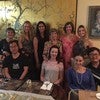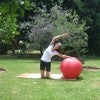Description
About This Video
Transcript
Read Full Transcript
Hi, this is Amy and I'm in Boulder, Colorado at the Palati Center, and I'm with Amy, one of the founders, and she's got something fun for me. I think. So if I were asked what something that you should all be doing, it doesn't matter if you're young, you're old, you're healthy, you're struggling, it really doesn't matter. Your feet, your feet, your feet are two of the most important things you own. All right? So we're going to do what we call the standing foot exercises. You can do small versions, you can do the whole thing. You can do one minute, you can do five minutes, you get to choose. I brought my little toy with me because I want you to understand that the foot is made like a springy arch, right? So that's our task.
Our problem today is we live on flat surfaces and typically in shoes. So our feet don't operate the way they should, and they're amazing, amazing, amazing structures. And you have one bone and then two bones, but then under here you have 26 more bones, 33 joints in each foot. That's a lot of movement. That should be happening and because there's a tremendous amount of tension in our feet, weakness in our feet, hardness in our feet, pain in our feet. We tend to think, oh, let's get a better shoe and stop using them instead of, hey, let's not get a better shoe. Let's make our feet work like feeders supposed to work again, so the arch of your foot should feel like this when you step on it.
Compression and then release and spring back into your art, right? Does your feet do your feet? Feel like that. Step on your foot and then release. And that not only is your shock absorption and your propulsion so that you're not aggravating the whole rest of your body, but it's also the pump mechanism to bring fluids back up to your heart. So essential, essential, essential couldn't really be more important, right? Very simple movements. We have a Cadillac here. You don't need a Cadillac.
You can hold onto a wall, you can hold on to your couch, you can hold onto your table. Doorframe doesn't really matter. You can do this with nothing holding onto nothing as well as you get a little more advanced, can even make it more advanced by closing your eyes. You can even make it more advanced by doing it on one foot, most advanced by doing it on one foot. No hands closed eyes. What am I going to start like this when we do it? Okay, so you're just going to take a natural hip width stance, okay? Right now, first you're just gonna bend your knees and straighten your knees. That can be harder than it's ounce. All right?
And you're trying to make sure that the knees don't collide, nor do they sway out, right? So your heading those knees over your second toe, you can think right and you imagine a wall behind you so that you don't go forward into your knees, right? So there's no pressure. If I had my hand on her knee as she bends, I wouldn't feel pressure coming forward because then you can feel a little knee strain. So you're just practicing. You're kind of lubricating joints, testing them out, right? At the same time, you sort of imagine your feet a little springy, a little like you've inch warm them up or like there's a little suction cup in there. Okay, so then when you start to feel like, okay, I'm getting warmed up, I'm feeling my feet, I'm starting to move. You add the next component. So you bend the knees, you stay this low. It's actually harder than it sounds too, and you lift your heels and lower your heels, right?
So now we're really starting to articulate our feet. We're trying to make use of those 33 joints in there that are sprung together with cables, ligaments, and tendons, et Cetera, that enable that springy arch, right? Again, you're keeping your alignment. You imagine this wall behind you, your way to stay on your feet. It's not moving forward and backwards in space. It just stays right like a plum line three, you okay? Next phase should you want to add it? You bend the knees, you lift the heel, staying low. Then you straighten and stretched tall and lower your heels.
Now you can just do that phase. Just going up and down. This, you could even do on the edge of a stair. You could go a little bit low or get a little extra stretch in the calf. Cause our calves often tend to be very tight. So just going up and down. Okay, so then the whole sequence is bend. Lift the heels, lift up tall, pull yourself up nice and tall, lower your heels, right? Then you could reverse it. Lift up tall. This movement's actually quite challenging to staying tall. Bend your knees, then roll your heels down and straight. And so let's do that again.
Rise up. Then your knees roll through your feet straight. And so the whole sequence looks like bend your knees, lift your heels, straighten up, lower down. You could do that. Maybe you do that three or four times. And reverse straight up. First, bend the knees.
Remember over the toes, no weight shift. Roll through those feet and straight. All right? And as I said, a little harder with no hands, a lot harder, closed eyes, a lot harder. One leg. And when you go try and do it on one leg, you're going to really discover discrepancies between your right and your left. So you might decide you're going to do a lot more on one leg than the other. Start on your weaker side.
Do your stronger side and come back and repeat your weaker side. Okay? So keep it simple or pull it all the way up. So depending on who you are, where you are today, this is a great exercise. It feels great too. Thank you, Amy. Here, welcome. Thank you. See you next time.
Comments
Heather, the more we get foot work out there with such a distinguished messenger as Amy Taylor Alpers, the more people will love what folks who practice Nia already know.
What would Debbie Rosas (founder of Nia for those who don't know) say about the feet anyway...
Benefits of Barefeet Exposed
Debbie and I were on the same dissecting team this year in Gil Hedley's lab... LOVE her!
Thank you!
You need to be a subscriber to post a comment.
Please Log In or Create an Account to start your free trial.























